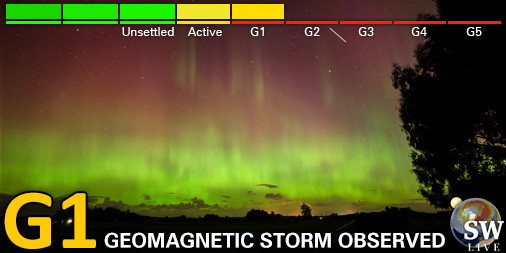Viewing archive of Friday, 13 April 2001
Geophysical report
Any mentioned solar flare in this report has a scaling factor applied by the Space Weather Prediction Center (SWPC). Because of the SWPC scaling factor, solar flares are reported as 42% smaller than for the science quality data. The scaling factor has been removed from our archived solar flare data to reflect the true physical units.
Solar and Geophysical Activity Summary 2001 Apr 13 0245 UTCPrepared by the NOAA © SWPC and processed by SpaceWeatherLive.com
Joint USAF/NOAA Solar and Geophysical Activity Summary
SGAS Number 103 Issued at 0245Z on 13 Apr 2001 This report is compiled from data received at SWO on 12 AprA. Energetic Events
Begin Max End Rgn Loc Xray Op 245MHz 10cm Sweep 0256 0304 0329 9415 S22W38 M1.3 1n 0840 0841 0841 120 0939 1028 1049 9415 S19W43 X2.0 Sf 8200 1200 II/IV 1145 1146 1159 130 1210 1216 1232 100 1956 1956 1957 160
B. Proton Events
The greater than 10 MeV proton event that began
at 0850 UTC on 10 April continues in progress. The maximum was 355
PFU at 11/2055 UTC and the flux at the end of the day on 12 April
was 31 PFU. A greater than 100 MeV proton event began at 12/1305
UTC, attained maximum of 1.5 PFU at 12/1725 UTC, and ended at
12/2010 UTC.
C. Geomagnetic Activity Summary
The geomagnetic field ranged from
quiet to severe storm levels.
D. Stratwarm
none
E. Daily Indices: (real-time preliminary/estimated values)
10 cm 149 SSN 159 Afr/Ap 045/038 X-ray Background B8.1 Daily Proton Fluence (flux accumulation over 24 hrs) GT 1 MeV 1.0e+08 GT 10 MeV 4.3e+06 p/(cm2-ster-day) (GOES-8 satellite synchronous orbit W75 degrees) Daily Electron Fluence GT 2 MeV 5.60e+06 e/(cm2-ster-day) (GOES-8 satellite synchronous orbit W75 degrees) 3 Hour K-indices Boulder 7 5 5 3 3 3 2 1 Planetary 7 6 5 5 3 3 1 2
F. Comments
None
All times in UTC
Current data suggests there is a slight possibility for aurora to appear at the following high latitude regions in the near future
Iqaluit, NUNuuk
Tórshavn
Reykjavik
Trondheim
Latest news
Latest forum messages
Unexplained proton activity 57Unspecified geomagnetic activity 2192AR4048 110SolarMax and FRAM2 2Changelog/Featurelog 169
More topicsSupport SpaceWeatherLive.com!
A lot of people come to SpaceWeatherLive to follow the Sun's activity or if there is aurora to be seen, but with more traffic comes higher server costs. Consider a donation if you enjoy SpaceWeatherLive so we can keep the website online!

Latest alerts
00:15 UTC - Geomagnetic activity
Minor G1 geomagnetic storm (Kp5) Threshold Reached: 23:59 UTC
Thursday, 3 April 2025
20:15 UTC - Geomagnetic activity
Minor G1 geomagnetic storm (Kp5) Threshold Reached: 20:02 UTC
13:03 UTC - Hemispheric Power Index
The OVATION model predicts the Hemispheric Power Index to reach 50GW at 13:56 UTC
Wednesday, 2 April 2025
04:03 UTC - Hemispheric Power Index
The OVATION model predicts the Hemispheric Power Index to reach 50GW at 04:56 UTC
Space weather facts
| Last X-flare | 2025/03/28 | X1.1 |
| Last M-flare | 2025/04/01 | M2.5 |
| Last geomagnetic storm | 2025/03/27 | Kp5 (G1) |
| Spotless days | |
|---|---|
| Last spotless day | 2022/06/08 |
| Monthly mean Sunspot Number | |
|---|---|
| February 2025 | 154.6 +17.6 |
| April 2025 | 152.5 -2.1 |
| Last 30 days | 130.6 -15.9 |




